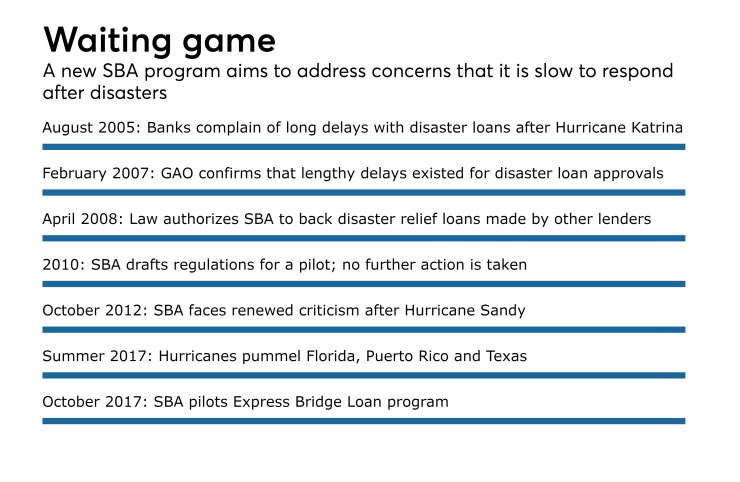The Small Business Administration is turning to banks and other lenders for help in remedying a persistent gap in its response to natural disasters.
A new pilot program will allow existing participants in the SBA Express program to make government-guaranteed disaster loans to of up to $25,000 to small businesses. The loans will be limited to the lenders’ existing banking relationships.
While the

An immediate cash infusion, even a modest one, “does a lot for a business that needs water, needs tarps and needs to get their employees some money to stay in the neighborhood until things can be sorted out,” said Dianna Seaborn, director of the SBA’s Office of Financial Assistance.
As restricted as it is, the program marks the first time the SBA has opened disaster lending up to banks. The agency began “brainstorming” and talking with lenders in the wake of Hurricane Irma, which devastated Puerto Rico and South Florida in September, Seaborn said. Puerto Rico was also hit hard by Hurricane Maria.
Those discussions revealed that lenders had little desire to supplant the federal government’s primary role in disaster-relief efforts, but they were willing to play a more limited role “if it was easy enough and cost-effective,” Seaborn said.
“All they needed was some streamlined processes,” Seaborn added. “When you underwrite a normal loan, there’s a lot more to it than when you’re looking at putting $25,000 out to someone who’s standing in front of a building with no roof.”
The pilot program will run through September 2020, said William Manger, associate administrator for the SBA’s Office of Capital Access.
Bankers have
After Hurricane Katrina struck in August 2005, bank groups complained about a sluggish SBA response while pleading for the ability to process disaster-relief loans. A 2007 Government Accountability Office report found that, months after Katrina, the agency was taking an average of 74 days to process applications. Its target was 21 days.
Congress subsequently passed the Small Business Disaster Response and Loan Improvements Act of 2008, which authorized the SBA to guarantee disaster credits made by private lenders.
That law envisaged lenders being allowed to make disaster loans as large as $2 million. The SBA, however, made little progress on the regulations necessary to convert Congress’ intent into a functioning program.
While it never addressed provisions allowing larger loans, the agency did draw up plans for an Immediate Disaster Assistance Program, or IDAP, for bridge loans up to $25,000. An April 2017 Government Accounting Office report found that lenders were leery of some of the program’s terms, including a 10-year repayment window.
Congress in 2010 provided the SBA with $3 million to create a pilot program to test the IDAP, but the agency never spent the funds. With the Express Bridge Loan program in place, the SBA has asked Congress to rescind IDAP, along with the $3 million appropriation.
“We wanted to figure out how we could leverage our existing loan guarantee programs into some activity here without having to create a new mechanism of delivery,” Seaborn said.
SBA Express, which handles about 20,000 normal loan applications a year, seemed a natural fit.
Normally, SBA Express offers 50% guarantees on loans of up to $350,000. The agency chose it to serve as the framework for the pilot because it permits participating lenders to use their own documents and underwriting processes, “which eliminates some of the typical bureaucracy that comes with federal programs,” Seaborn said.
With quick turnarounds in mind, the SBA also streamlined the documentation required for disaster loans. Borrowers only need to show that their business is operational, all federal taxes have been paid and that it is located in the area covered by the disaster proclamation.
“We would make the presumption that there was not credit available elsewhere, which is one of the key tenets of our program,” Seaborn said.
Borrowers have up to seven years to repay disaster-relief loans under the pilot program. They are also permitted to repay using proceeds of any larger disaster-relief loans they obtain later.
As the government’s go-to agency for disaster relief, along with the Federal Emergency Management Agency, the SBA is authorized to make disaster loans of up to $2 million to small businesses that have suffered economic injury or physical damage from a natural catastrophe. It will continue making those loans.
The SBA’s response to a recent spate of disasters, including hurricanes in Texas, Florida and Puerto Rico, as well as the California wildfires, has been timelier, Manger said. The SBA has approved about 80% of the roughly 225,000 disaster-loan applications tied to those disasters.
“We’ve gotten out close to $3 billion” to date, Manger said.
To accomplish that, the SBA has expanded its disaster staff to more than 4,800 employees and opened 106 satellite offices in Texas, Florida and Puerto Rico.
“Certainly a lot has been learned since” the agency had to deal with a spate of hurricanes in 2005, Manger said.
Though the SBA is already processing some Express Bridge Loan applications, Seaborn said she expects the number tied to Harvey, Irma and the California wildfires to be relatively small.
“The farther away you get from the onset of the disaster, the more likely you are going to be in the permanent disaster-loan process,” Seaborn said. “We weren’t timely enough to play a role in the current disasters.”
The SBA has continued to back loans made under its flagship 7(a) lending program in areas affected by disasters, Manger said. Since Oct. 1, the agency has guaranteed 545 loans under the program, totaling more than $250 million in Florida, along with 28 loans totaling nearly $9 million in Puerto Rico.





